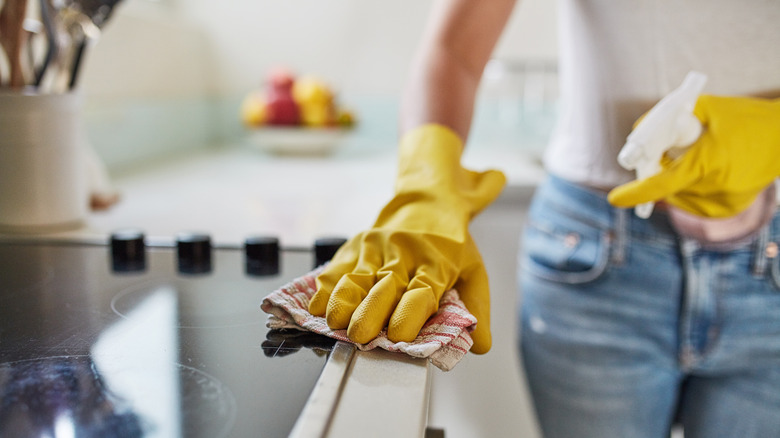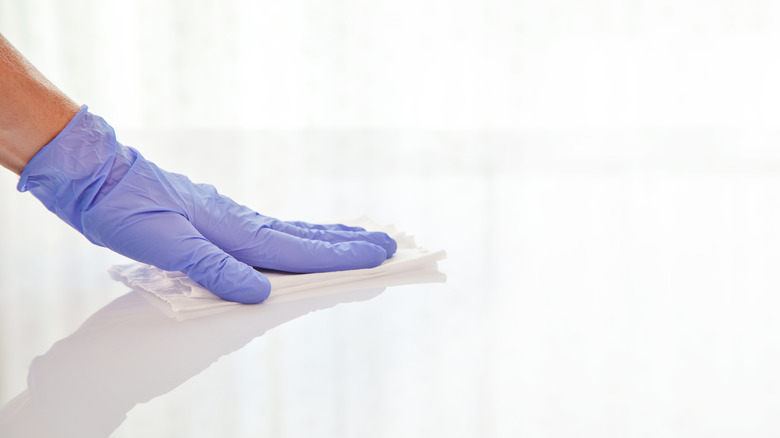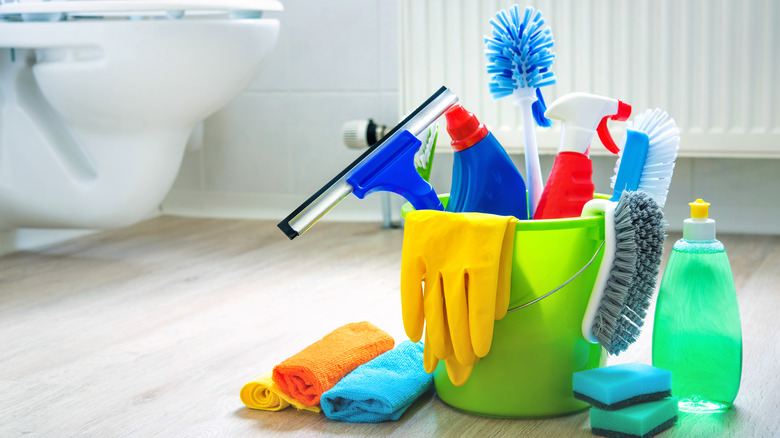Are You Leaving Disinfectant Sprays On Your Surfaces Long Enough While Cleaning?
Household cleaners simplify our lives, helping us slow the spread of germs and keeping mold and mildew at bay. Your instinct might be to spray, wipe, and walk away, but that may be placing too much faith in the omnipotence of disinfectants. Every product has what's known as a dwell time, which is the amount of time a product needs to sit on a surface to kill germs effectively. "Most household disinfectant holds a three- to 10-minute dwell time, which means the product needs to sit wet on a surface for it to actually disinfect," president and CEO of MaxiMaids Karina Neff told Reader's Digest. "Also note that it's important to remove debris or dirt from the surface with a microfibre towel before disinfecting," Neff continued.
Because these dwell times can vary drastically, it's important always to confirm how long a product should sit by checking the label. Every cleaning product approved by the EPA has this dwell time, also known as a contact time, so you can always make sure you're following best practices. If your disinfectant is a diluted bleach solution, the CDC recommends letting the solution sit for at least a minute before wiping. Make sure you're always using a fresh solution; bleach becomes less effective the longer it's been diluted in water.
How to follow contact times
When a product lists its dwell time, it refers to the time frame a solution has to sit on a surface, visibly wet, before wiping off can be effective. This means that products with a longer dwell time, or alcohol-based ones that tend to dry faster, will need to be applied repeatedly for the duration of the listed contact time, or it won't work effectively.
Sanitation frequency differs for various parts of your home. You should prioritize those high-touch areas where germs tend to accrue the most: areas like light switches and doorknobs, as also remote controls, computer keyboards, and bathroom fixtures. Your kitchen is another space that needs regular disinfecting, especially if you live in a household where meat is prepared. Your kitchen sink, in particular, can be a hotspot for all kinds of bacteria, as it is the receptacle for runoff from hand-washing, food preparation, and questionable kitchen sponges, meaning it should get regular quality time with a disinfectant. In addition to regular cleaning practices, you should also disinfect your home if a member of your household has been sick recently.
Cleaning vs. disinfecting
When it comes to removing germs, there's an important distinction between cleaning and disinfecting. Cleaning means simply applying soap and water to a surface and scrubbing. However, this doesn't require harsher chemicals like bleach as it can be enough to eliminate a lot of the germs that lurk on surfaces. The next step is sanitizing, which reduces germs using weaker chemical solutions, and the most extreme step is disinfecting, which is meant for heavy-duty situations where bacteria and viruses need to be killed entirely. When using disinfectants to sanitize or disinfect, it's crucial to first clean surfaces with soap and water. Otherwise, lingering dirt or mess can make your solution less effective at killing germs.
Whenever you are applying disinfectant, whether, via a spray or a sponge soaked in a solution, it's important to keep reapplying your cleaner as you move between surfaces. Disinfectant wipes can give you a false sense of security and simply spread germs from one surface to the next, so make sure you're tossing and grabbing a new one out of the container regularly as you move across your home.


